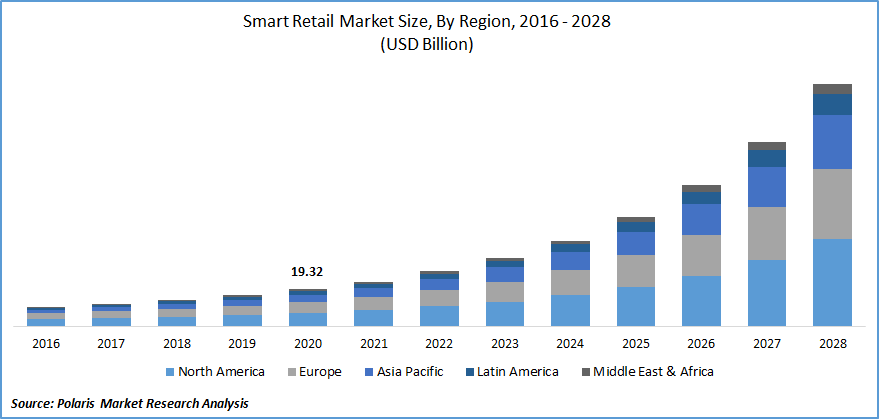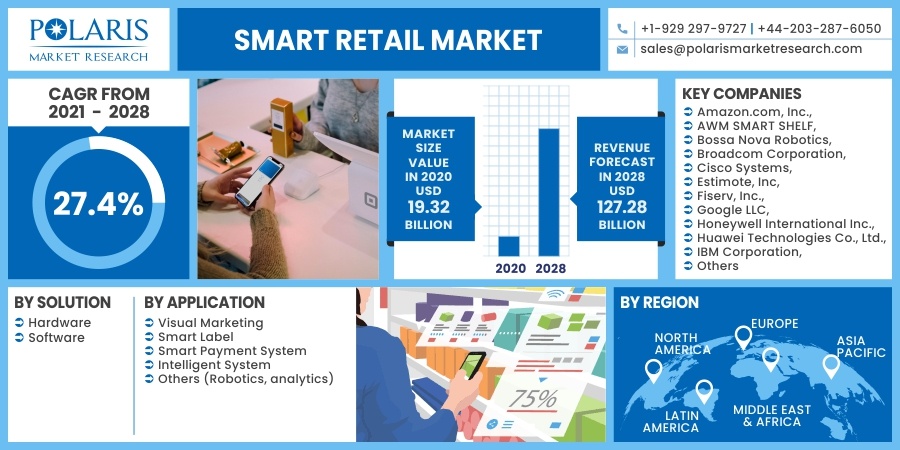
Smart Retail Market Share, Size, Trends, Industry Analysis Report, By Solution (Hardware, Software), By Application, By Regions; Segment Forecast, 2021 – 2028
- Published Date:Oct-2021
- Pages: 111
- Format: PDF
- Report ID: PM1995
- Base Year: 2020
- Historical Data: 2016 - 2019
Report Outlook
The global smart retail market was valued at USD 19.32 billion in 2020 and is expected to grow at a CAGR of 27.4% during the forecast period. The proliferation of the internet along with the increasing implementation of the augmented reality (AR) assists in building relationships with the consumer across the globe. For instance, in March 2017, Lowe’s introduced the company’s new in-store navigation app-Lowe’s Vision. It is the first application that uses augmented reality for indoor mapping.
In addition, growing awareness for the foot traffic in the retailing sector provides insights regarding various aspects of stores and helps retailers plan strategies as per the purchase history of the end-users. Therefore, these factors may positively influence the smart retail market growth in the foreseen period. Furthermore, the rising applications for smart transportation or logistics in the smart retail aids in tracking delivery vehicles or monitors the pathways with the help of GPS navigations also stimulate smart retail market growth.
 Know more about this report: request for sample pages
Know more about this report: request for sample pages
The COVID-19 crisis has shown an adverse impact on the market, and mandatory restrictions on logistics and travel affect the supply chain of smart retail. Trade barriers are limiting the outlook of the market demand and supply. Various governments announced a temporary shutdown of industries and lockdowns in multiple regions that negatively affect production. Also, deliveries of the goods have been delayed for the customers along with the retailers. However, the gradual opening of lockdowns and the adoption of technologies may show considerable growth in the market of the smart retail industry over the forecasting years.
Industry Dynamics
Growth Drivers
The global market witnessed considerable growth due to the growing adoption of automation and robotics in the retail industry. The increasing implementation of the various automation techniques to eradicate mistakes & accuracy and boost productivity fosters the smart retail market growth. In addition, retail robots capture the customer purchasing pattern and collect rough data about the goods on shelves. This raises the efficacy and accuracy in the management of stock.
Moreover, smart retail devices also offer quick, consistent & precise control and improve the delivery pattern. Furthermore, the growth of IoT-based devices & real-time data analytics in the market also shows a positive impact on the smart retail industry. Populations are rapidly shifting towards automation-based services and solutions, stimulating the market demand for AI, real-time data analytics, and IoT-based devices. Real-time data analytics gives a broad network for seamless data transfer. Therefore, the rising implementations of robotics & automation and technological developments in real-time data analytics are contributing to the global retail industry growth in the upcoming scenario.

Know more about this report: request for sample pages
Report Segmentation
The market is primarily segmented on the basis of solution, application, and region.
|
By Solution |
By Application |
By Region |
|
|
|
Know more about this report: request for sample pages
Insight by Solution
The hardware segment held the largest share of revenue in the global market in 2020. The implementation of Virtual Reality (VR) and Augmented Reality (AR) devices, Radio-frequency identification (RFID) systems, Bluetooth beacon, as well as point of sale (POS) systems is increasing across various industries. Therefore, it offers a perfect in-store shopping experience to its consumers, fueling the segment growth across the globe which in turn will propel the market of the smart retail industry.
The software segment is accounted for the fastest-growing revenue share in 2020 over the forecast period of 2021-2028. Increasing penetration of the analytic software by the market vendor leads better understanding of the consumer's behavior and requirement. This is one of the key factors for the segment growth as it presents a complete shopping experience and customer management which will fuel the retail industry growth. Moreover, the growing significance of customer-centric marketing and shifting consumer preferences are also leading the segment growth with rising investments in the retail sector. This may create a massive opportunity for analytic software in smart retail activities in the upcoming years.
Insights By Application
The visual marketing segment is anticipated to spot with dominating position in the global market. The vendors are engaging customers through digital signage, state-of-the-art lighting, storefronts, and interior displays as a major need for the smart retail solution. Besides, social media platforms gain a huge consumer base of the millennial for marketing activities. It facilitates retailers to focus on offering a seamless shopping experience with the least hindrance in social media.
Moreover, the expansion of the e-commerce sector also creates many opportunities for brick-and-mortar stores as they adopt visual marketing for advertising their goods. Therefore, an increasing number of these stores present several snapshots or videos of their products and act as the catalyzing factor for the segment growth worldwide which in turn will fuel the market of the smart retail industry.
The smart payment system segment is expected to accelerate at a lucrative rate in the forthcoming years. The rising number of initiatives for encouraging digital payments and increasing requirements for improving consumers' experiences attribute towards the segment growth. In addition, the increasing needs of the POS solutions due to the considerable growth of cashless transactions and mobile payment apps, e-payments, and other payment solutions, thus, may drive the retail market development. Hence, the growing adoption of mobile wallets may contribute to segment growth in the near future.
Geographic Overview
Geographically, North America dominated the global market with the largest revenue share in 2020. The increasing market demand for superior and luxurious products across the region and shifting consumer preferences towards the modernized society market demands for more convenient and developed products leads the smart retail industry growth. In addition, the presence of the numerous departmental stores, hypermarkets or supermarkets, and other types of retail stores deploys more retrieval systems, POS solutions, and automatic storage, self-checkout systems in the premises. Therefore, these factors contribute to North America's market growth as they are an early adopter of the latest solutions available in the market.
Moreover, Asia Pacific is anticipated to project the highest CAGR in the global market in the forthcoming scenario. Increasing implementation of smart retail solutions such as shopping guide robots, big data analytics, reception robots, intelligent dressing mirrors in the nations like China and Japan is leading the smart retail regional market growth. Moreover, major as well as small retailers are selecting this platform for enhancing their business operations. For instance, the Vivo manufacturing brand of smartphones introduced the company's smart retail in India to help retailers monitor the market demand for smartphones by opting for this smart retail network. Furthermore, the growing number of acquisitions by the major companies is also a catalyzing factor, which is gaining significant prominence across the region.
Competitive Landscape
Some of the major players operating the global market include Amazon.com, Inc., AWM SMART SHELF, Bossa Nova Robotics, Broadcom Corporation, Cisco Systems, Estimote, Inc, Fiserv, Inc., Google LLC, Honeywell International Inc., Huawei Technologies Co., Ltd., IBM Corporation, Ingenico, Intel Corporation, LG Display Co., Ltd., NCR Corporation, PAR Technology Corporation, PAX Global Technology Limited, Pricer, PTC, Robert Bosch GmbH, Samsung Electronics, SoftBank Robotics, Standard Cognition, Corp., Verifone Systems, and Zippin.
Smart Retail Market Report Scope
|
Report Attributes |
Details |
|
Market size value in 2020 |
USD 19.32 billion |
|
Revenue forecast in 2028 |
USD 127.28 billion |
|
CAGR |
27.4% from 2021 - 2028 |
|
Base year |
2020 |
|
Historical data |
2016 - 2019 |
|
Forecast period |
2021 - 2028 |
|
Quantitative units |
Revenue in USD million/billion and CAGR from 2021 to 2028 |
|
Segments covered |
By Solution, By Application, By Region |
|
Regional scope |
North America, Europe, Asia Pacific, Latin America, Middle East & Africa |
|
Key Companies |
Amazon.com, Inc., AWM SMART SHELF, Bossa Nova Robotics, Broadcom Corporation, Cisco Systems, Estimote, Inc, Fiserv, Inc., Google LLC, Honeywell International Inc., Huawei Technologies Co., Ltd., IBM Corporation, Ingenico, Intel Corporation, LG Display Co., Ltd., NCR Corporation, PAR Technology Corporation, PAX Global Technology Limited, Pricer, PTC, Robert Bosch GmbH, Samsung Electronics, SoftBank Robotics, Standard Cognition, Corp., Verifone Systems, Zippin |
